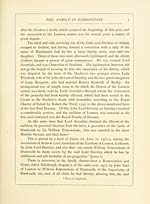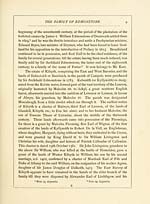Download files
Complete book:
Individual page:
Thumbnail gallery: Grid view | List view

GENEALOGICAL ACCOUNT OF
William, to hold the said lands immediately of the King, and for that purpose
confirming a charter by King James II. (1452) to the said William in
respect of the great kindness, labour, and expense of the said William, in
recovering the Earl's part of the Earldom of Lennox.
There is likewise an instrument, dated 27th October of the same year,
of the lands of Duntreath, etc., in favour of William Edmonstone, upon a
declaration made by another of the heirs and claimants to the Lennox
Estates, Elizabeth, grand-daughter of the Lady Elizabeth Monteith,
married to John Napier of Merchiston, that in pursuing her claim to a
fourth part of the lands of the Lennox, she makes none on those of the said
William Edmonstone.
Lastly, there is an instrument of the 5th of the same month, exempting
the Barony of Duntreath from the jurisdiction of the Earl of Lennox's
Courts. Nothing was thus omitted to secure to the proprietor of the
Duntreath estate the full exercise of his Baronial powers.
In 1614 the lands and barony of Duntreath were wadsetted or
mortgaged, together with the office of Coroner of the Shyre, by Sir
James Edmonstone and his son William, to Sir William Livingston of
Kilsyth, redeemable on the payment of 60,00c) 1 merks, which redemption
happily took place sixteen years after (1630) by Archibald, son of the above
William, and Duntreath has ever since been the principal seat of the
family. A considerable portion, however, of the original estate was never
recovered.
At what time the Castle was first built is unknown, but it was one of
the fortalices belonging to the Lennoxes, to which considerable additions
were subsequently made. The last of these additions appears to have been
made by Sir James Edmonstone about the end of the sixteenth century,
and a stone with the family arms engraved, with the cypher S. J. E. still
remains. The Castle consists of a quadrangle, of which the south side
never was completed. As the family latterly resided principally in Ireland,
the house fell into decay, and it is said that the factor having received
orders to cover a neighbouring farm-house with slates, unroofed the old
mansion- for that purpose about the middle of the last century.
Broadisland in the county of Antrim, in Ireland, was purchased the
1 Note 12, Appendix.
William, to hold the said lands immediately of the King, and for that purpose
confirming a charter by King James II. (1452) to the said William in
respect of the great kindness, labour, and expense of the said William, in
recovering the Earl's part of the Earldom of Lennox.
There is likewise an instrument, dated 27th October of the same year,
of the lands of Duntreath, etc., in favour of William Edmonstone, upon a
declaration made by another of the heirs and claimants to the Lennox
Estates, Elizabeth, grand-daughter of the Lady Elizabeth Monteith,
married to John Napier of Merchiston, that in pursuing her claim to a
fourth part of the lands of the Lennox, she makes none on those of the said
William Edmonstone.
Lastly, there is an instrument of the 5th of the same month, exempting
the Barony of Duntreath from the jurisdiction of the Earl of Lennox's
Courts. Nothing was thus omitted to secure to the proprietor of the
Duntreath estate the full exercise of his Baronial powers.
In 1614 the lands and barony of Duntreath were wadsetted or
mortgaged, together with the office of Coroner of the Shyre, by Sir
James Edmonstone and his son William, to Sir William Livingston of
Kilsyth, redeemable on the payment of 60,00c) 1 merks, which redemption
happily took place sixteen years after (1630) by Archibald, son of the above
William, and Duntreath has ever since been the principal seat of the
family. A considerable portion, however, of the original estate was never
recovered.
At what time the Castle was first built is unknown, but it was one of
the fortalices belonging to the Lennoxes, to which considerable additions
were subsequently made. The last of these additions appears to have been
made by Sir James Edmonstone about the end of the sixteenth century,
and a stone with the family arms engraved, with the cypher S. J. E. still
remains. The Castle consists of a quadrangle, of which the south side
never was completed. As the family latterly resided principally in Ireland,
the house fell into decay, and it is said that the factor having received
orders to cover a neighbouring farm-house with slates, unroofed the old
mansion- for that purpose about the middle of the last century.
Broadisland in the county of Antrim, in Ireland, was purchased the
1 Note 12, Appendix.
Set display mode to:
![]() Universal Viewer |
Universal Viewer | ![]() Mirador |
Large image | Transcription
Mirador |
Large image | Transcription
Images and transcriptions on this page, including medium image downloads, may be used under the Creative Commons Attribution 4.0 International Licence unless otherwise stated. ![]()
| Histories of Scottish families > Genealogical account of the family of Edmonstone of Duntreath > (26) Page 8 |
|---|
| Permanent URL | https://digital.nls.uk/95353767 |
|---|
| Description | A selection of almost 400 printed items relating to the history of Scottish families, mostly dating from the 19th and early 20th centuries. Includes memoirs, genealogies and clan histories, with a few produced by emigrant families. The earliest family history goes back to AD 916. |
|---|

